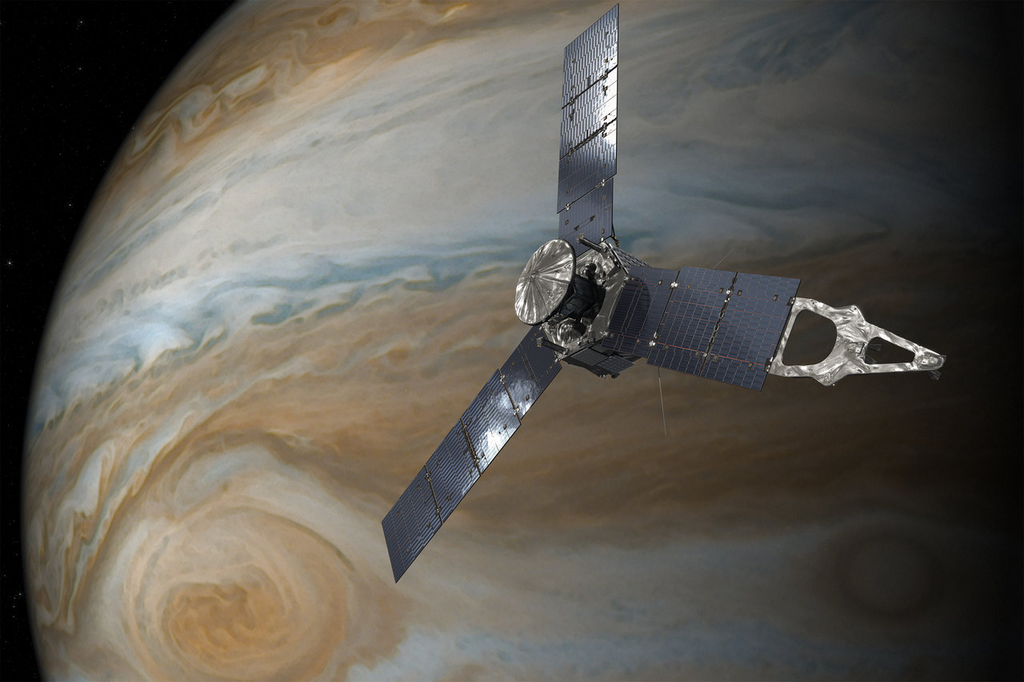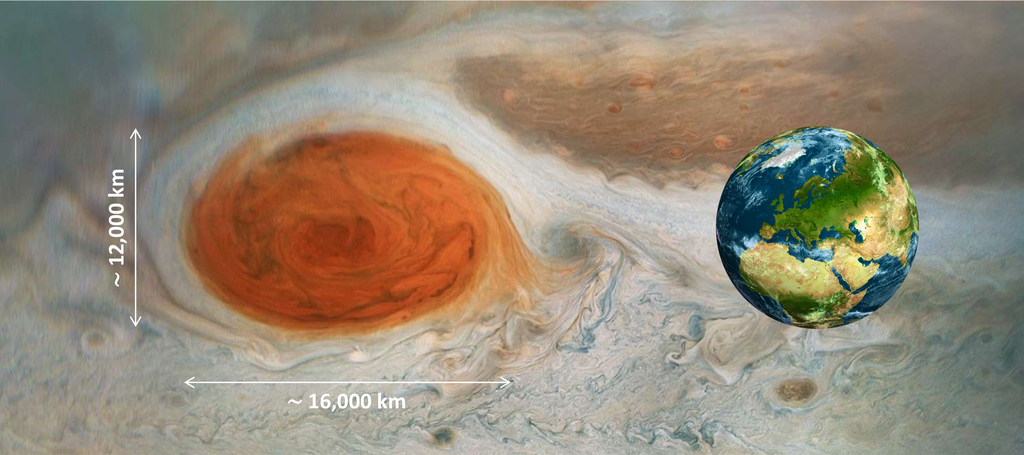
Jupiter's Great Red Spot: an anticyclonic storm of "constrained" depth
Jupiter is the largest planet in the solar system, with an equatorial radius of 71,492 km, and is composed mainly of hydrogen and helium, which is why it is called a "gas giant".
Perhaps the planet's most iconic feature is the Great Red Spot, an anticyclonic storm probably discovered by Giandomenico Cassini in 1665. Today, it resembles an oval approximately 16000 x 12000 km in size, making it the largest storm in the solar system. However, it has shrunk considerably in the last 100 years for reasons still unknown. The Great Red Spot still raises many questions, one of which concerns the depth at which this storm extends into Jupiter.
This and other questions about the size of the central core have been answered by the Juno spacecraft, which NASA carried out with a major Italian contribution.
During two close flyovers of Jupiter (February and July 2019), NASA's Juno mission (which has been in orbit around Jupiter since July 5, 2016, to study the gas giant’s formation mechanisms, internal structure, magnetosphere and atmosphere) has observed the Great Red Spot up close for the first time. Since the planet's interior is not directly observable, accurate measurements of the gravitational field, which is an expression of the mass distribution within Jupiter, are used to understand its innermost structure.
Measurements of the planet's gravitational field had shown that strong east-west winds (with speeds of up to 360 km/h), visible by tracking the motion of the top clouds, reach a depth of about 3000 km.
Today, new research, partly funded by the Italian Space Agency (ASI) and coordinated by Marzia Parisi, a former PhD student at Sapienza University, now a post-doctoral fellow at the California Institute of Technology/Jet Propulsion Laboratory, together with an international group including Daniele Durante and Luciano Iess of the Sapienza's Department of Mechanical and Aerospace Engineering, shows that the winds of the Great Red Spot have a rather shallow vertical penetration depth of about 300 km, much less than the winds blowing in the visible bands of the planet. The results of the work have been published in the Science journal.
"Our study," says Daniele Durante of the Department of Mechanical and Aerospace Engineering of Sapienza University of Rome, "shows that the storm's mass is about half that of the Earth's entire atmosphere and slightly less than that of all the water in the Mediterranean Sea. The Great Red Spot is represented as an object very similar to a very large disk (its smallest dimension is roughly equal to the diameter of the Earth) but rather thin, with characteristics reminiscent of those of the largest terrestrial storms."
With a very eccentric orbit, the Juno probe was able to get very close to the gas giant, up to 4-5000 km above the clouds: at these distances, it is possible to have a high sensitivity to the gravitational acceleration exerted on Juno mainly by the structures of the planet's atmosphere. The probe used the KaT radioscience instrument (Ka-Band Translator, built by Thales Alenia Space-I and funded by the Italian Space Agency), the heart of the experiment that allowed the vertical extension of the Great Red Spot to be determined.
The Great Red Spot imperceptibly disturbed Juno's orbit, but the extreme accuracy of the measurement (down to 0.01 mm/s) made it possible to capture its very faint gravitational signal and thus estimate its depth at about 300 km.
"Juno's measurements,” concludes Luciano Iess of the same Department, "have provided the third dimension to the phenomenon of Jupiter's atmosphere that has attracted the attention of many of us, as well as that of astronomers for more than three hundred years, showing it to be a superficial storm that is certainly very extensive, but also very shallow. This new measurement will help to understand its nature, its evolution and, perhaps, its possible disappearance."
References:
The depth of Jupiter’s Great Red Spot constrained by the Juno gravity overflights – Marzia Parisi, Yohai Kaspi, Eli Galanti, Daniele Durante, Scott J. Bolton, Steven M. Levin, Dustin R. Buccino, Leigh N. Fletcher, William M. Folkner, Tristan Guillot, Ravit Helled, Luciano Iess, Cheng Li, Kamal Oudrhiri, and Micheal H. Wong. Science 2021 DOI: 10.1126/science.abf1396
Further Information
daniele.durante@uniroma1.it





